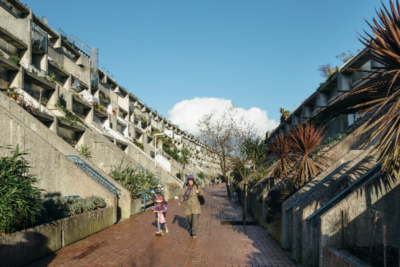Pioniere del social housing, poco prima della scomparsa aveva ricevuto la Royal Golden Medal, il più prestigioso riconoscimento alla carriera del mondo britannico, per l’edificio che gli rovinò la sua carriera: Alexandra Road a Londra
«The Royal Gold Medal is entirely unexpected and overwhelming. It’s a recognition of the significance of my architecture, its quality and its current urgent social relevance. Marvellous!»
«La Royal Golden Medal è completamente inaspettata e travolgente. È un riconoscimento dell’importanza della mia architettura, della sua qualità e della sua attuale ed urgente rilevanza sociale. Magnifico!»
(Neave Brown)
Questa è stata la reazione di sorpresa di Neave Brown quando fu insignito della Royal Golden Medal 2018 lo scorso ottobre, appena pochi mesi prima della sua scomparsa avvenuta a gennaio. Parole sincere che non nascondono un certo sollievo, considerato che il più prestigioso riconoscimento alla carriera del mondo britannico, approvato da Sua maestà la Regina, è arrivato a consacrarlo proprio con l’edificio che ne stroncò la carriera ancora giovanissimo: Alexandra Road.
In Italia si sa poco di lui, anche se lui amava molto il nostro paese che gli aveva dato una seconda possibilità aprendogli una strada internazionale con il progetto di Mozzo 1 a Bergamo. Lui infatti, che è stato l’unico architetto inglese ad avere tutti i suoi progetti protetti quando era ancora in vita, all’epoca non poteva più costruire nel Regno Unito a causa di un’indagine publica proprio su Alexandra Road.
Ma chi era Neave Brown e cosa significa questo premio in questo preciso momento storico?
Oggi considerato uno dei più grandi architetti modernisti britannici e un pioniere dell’architettura residenziale sociale, era solo un giovane architetto, con all’attivo appena un progetto di cinque case a schiera realizzato, quando fu assunto al London Borough of Camden da Sydney Cook. Era il 1965, gli investimenti nel pubblico erano al loro massimo e avevano innescato un circolo virtuoso nei Council londinesi. Cook aveva deciso che il suo dipartimento sarebbe diventato il primo nel campo del social housing, che avrebbe costruito più di mille residenze all’anno e per fare ciò aveva messo su una squadra di giovani architetti brillanti, i migliori talenti di Londra, pieni di energia e pronti a sperimentare per il bene della comunità: Peter Tábori, Gordon Benson, Alan Forsyth e la figura di spicco, Brown. Furono anni pieni di fermento e ricerca progettuale, di avanzamento della disciplina al servizio della città e del pubblico, fu uno di quei momenti in cui tutto sembra proprio come dovrebbe essere, una speciale alchimia economico-politico-architettonica che si respira tra le pagine di “Cook’s Camden: The Making of Modern Housing” pubblicato lo scorso settembre da Mark Swenarton.
Brown sviluppò il concetto di Low-Rise-High-Density a partire dal suo primo progetto di Winscombe Street, passando per le 72 residenze di Fleet Road, per arrivare al capolavoro di Alexandra Road con 522 unità, scuole, centro civico e un parco pubblico. Erano tre casi studio di un unico progetto, come lui stesso lo ha definito successivamente. Non credeva nella tipologia della torre, che portava alla segregazione sociale e non considerava sicura, credeva nel potere della strada, nella struttura urbana portata alla scala dell’edificio, nel concetto di comunità.
«In each case, I didn’t think I was designing social housing, but just housing. Good London housing»
«In ogni caso non pensai mai al fatto che stavo progettando residenze sociali, ma solo residenze. Residenze ben fatte a Londra»
Il sogno finì presto, nel 1970 l’inflazione annuale toccò il picco del 25%, dalla fine degli anni ’70 gli investimenti pubblici furono ridotti e con lo schema chiamato right-to-buy messo in atto dal governo di Margaret Thatcher nel 1980 ci fu un radicale cambio di strategia verso il social housing. In questo clima generale Alexandra Road Estate fu completata nel 1979, fuori tempo e costo, e questo portò a un’indagine pubblica da cui Brown uscì innocente, ma con la reputazione completamente danneggiata.
Oggi la situazione del residenziale sociale in Inghilterra non sembra essere migliorata, la cosiddetta UK Housing Crisis diventa ogni anno più urgente e la soluzione sempre più difficile. Il documentario Dispossession di Paul Sng, in questi mesi in moltissime sale cinematografiche in Gran Bretagna, è un condensato densissimo di passato e presente dell’affordable housing, una rete intricatissima di programmi pubblici fallimentari e drammi personali, con un occhio sbieco al florido mercato immobiliare di lusso. Un contrasto senza uno spiraglio di luce. Sono gli anni in cui stiamo assistendo alla demolizione dei Robin Hood Gardens, progetto simbolo degli Smithson, dopo anni di allarme sociale dovuto alla mancanza di fondi per la manutenzione e in cui purtroppo abbiamo visto la tragedia della Grenfell Tower avvenire proprio sotto i nostri occhi increduli.
Per questo motivo la scelta del RIBA, Royal Institute of British Architecture, di consegnare la medaglia d’oro a Brown è molto importante per la nostra disciplina: perché dá speranza, porta i giovani architetti di oggi ad andare a visitare Alexandra Road e capire cosa ci fu di buono in quell’idea, aprendo nuove prospettive progettuali basate su un passato che ha funzionato, scuote l’opinione pubblica dimostrando la possibilità di un’alternativa, e chiede un’urgente risposta politico-economica ad un problema ormai tangibile.
Brown in un’intervista sulle pagine del Guardian poco dopo la premiazione dichiarò con la lucidità e la saggezza dei suoi 88 anni:
«I’m an old, old man, so my answer is probably not the right one, but I think we need a new national agency to govern standards and fund the construction of housing for properly mixed communities – crucially with maintenance costs financed for the whole life of the building.»
«Sono un vecchio, vecchio uomo, per cui la mia risposta é probabilmente non quella giusta, ma penso che ci serva una nuova azione nazionale per gestire gli standard e finanziare la costruzione di residenze per comunità miste – ed é fondamentale che i costi di manutenzione siano finanziati per l’intera vita dell’edificio.»
—







—
“Neave Brown building a Legacy” è un video realizzato dal RIBA che include il discorso di Brown del 2 ottobre 2017, dopo la premiazione:
L’ultimo dibattito pubblico di Brown ospitato dall’Architecture Foundation all’Hackney Empire il 27 ottobre 2017 è interamente visibile sul sito dell’Architecture Foundation.
Il documentario Dispossession di Paul Sng può essere guardato on-line, ordinato su dvd ed è ancora in programmazione nelle sale.
Il libro “Cook’s Camden: The Making of Modern Housing” di Mark Swenarton è stato pubblicato da Lundhumphries.
—
—
–
—
—
Ha detto lui
«I’m in a state of tiswas about it. I stopped following architecture years ago, so I had no idea there was this renewed interest in my work until recently. I thought my buildings were a curiosity of the past that people had largely forgotten about.»
06.10.2017, The Guardian. Interview by Oliver Wainwright
–
«It was an absolute nightmare (…) I couldn’t work in England ever again. And when Margaret Thatcher came to power, she swiftly destroyed everything we had worked for anyway, by scrapping social housing altogether.»
06.10.2017, The Guardian. Interview by Oliver Wainwright
–
«Now we are faced with the problem of dealing with the alternatives; a high-rise building, prefabrication, standardisation, preferred dimensions and we knew, and we were right, that they were a catastrophe.»
02.10.2017, RIBA. Golden Medal speech
–
«At a practical level our large plans and sections, showing pictorially what we want, are far cry from normal working drawings. They are handled with care in Bergamo; the builder works to a level of precision and skill almost forgotten here. Craftsmen want to know what you want, exactly, but don’t want to be told too much – in a city where the Association of Artisans is still among the most powerful lobbies. What they make will be beautiful. People look at drawings, ideas, designs and react. Bellissimo. My kind of town.»
11.1990, AT13, My Kind of Town. Neave Brown speaking about Mozzo 1
–
Hanno detto di lui
«I’m delighted to announce Neave Brown will receive the 2018 Royal Gold Medal. Neave’s contribution to the development of modern British housing is profound, inspiring to architects, local authorities and those who have benefitted from living in one of his outstanding projects. The UK must now look back at Neave Brown’s housing ideals and his innovative architecture as we strive to solve the great housing crisis. The Government must empower and then encourage every single Council across the country to build a new generation of well-designed, affordable and sustainable homes that meet the needs of the millions of people currently failed by the housing market. We need to build 300.000 new homes per year for the foreseeable future to tackle this crisis: a radical programme of mass council homes, inspired by Neave Brown’s work, must be part of the solution.»
02.10.17, RIBA website, RIBA President and Chair of the Selection Committee Ben Derbyshire
–
«Against the orthodoxy of slabs set in empty space, stemming from the ‘death of the street’ proclaimed by Le Corbusier, Brown created a model in which connections were based on the street and the building fabric was continuous with the surrounding urban tissue. In the act of making housing the architect was not simply ‘building in’ or ‘adding to’ the city, but actively remaking the city: strengthening its arteries – its streets – and thereby contributing to the health and wellbeing of urban society.»
02.10.17, RIBA website, Neave Brown by Mark Swenarton
–
«The award of the RIBA Royal Gold Medal is absolutely timely given the chaos and deep misery created by successive governments’ laissez faire attitude to housing and urbanism. It signals loud and clear the RIBA’s commitment to the social project of architecture, the redemptive capacity of buildings and our belief that the city is both a work of art and a powerful agent in the liberation of people and the improvement of their lives.»
02.10.17, RIBA website, Neave Brown by Peter Barber
–
«These and other small buildings are what Neave Brown contributed to the happiness of the world, but he also introduced many other architects to the special world of Camden architecture, and he inspired them and learned from them in an incredibly positive way.»
02.10.17, RIBA website, Neave Brown by Ted Cullinan
–
«If you said you lived in Rowley Way at this time, you got a raised eyebrow or a look of sympathy. There were times when no-one would deliver to our flats and if you were a pizza delivery boy you were likely to be relieved of your pizza before it reached it’s destination – or so it was rumoured. Throughout this time, Neave Brown, shall we say, ‘hung in there’ as did the residents, even creating a co-operative that managed the place for a 12 year duration.»
–
«The strength of the reaction to his RIBA Gold Medal was testament to how resonant Neave’s work was to a new generation (…)The lecture that we hosted was the largest lecture by a British architect ever and he was dumbfounded by its scale.
He really wanted to talk about the Grenfell Tower fire, as he’d always been a staunch opponent of accommodating social housing in towers. He was insistent that we needed a return to a kind of street-based urbanism because he felt that towers were socially divisive as well as unsafe.»
11.01.2018, Architects Journal, Ellis Woodman interviewed by Will Hurst, Greg Pitcher
About Author
Tag
londra , social housing
Last modified: 27 Aprile 2018



































[…] in cui la strada è portata alla scala dell’edificio – ne abbiamo parlato nell’articolo Neave Brown (1929-2018) -; ma anche la Baker Estate di Ralph Erskine Arkitektkontor, un ambizioso esempio di architettura […]